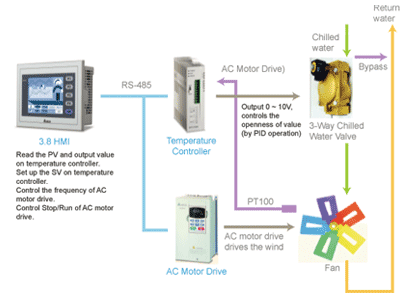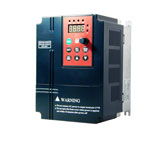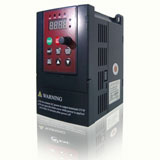Constant Temperature Control in Air-Conditioning System
Global warming is one of the greatest feared disasters in human history, and with its deteriorating effects, it should cause concern to all human beings. Combating global warming by reducing CO2 emission and saving energy are things we can do to help reduce the effects of global warming. Taiwan is located in the sub-tropical zone, therefore, every building is equipped with air-conditioning systems. If we adopt reasonable and intelligent technology, plus the best modern design, we can conserve energy, as well as maintain a comfortable working and living space.
As far as general commercial buildings are concerned, the traditional HVAC (heating, ventilating and air-conditioning) system consumes half of the entire electricity charged every month. However, with a highly efficient air-conditioning system, the electricity consumed can be reduced by 47.45%. That is to say, the cooling, heating and ventilation we actually demand would be far less than the energy consumed in the traditional air-conditioning system. In order to offer an efficient and energy-saving HVAC system, Gozuk integrates our advanced AC motor variable frequency drive, programmable logic controller, temperature controller and human machine interface, offering you an air-conditioning system solution that is not only environmental-friendly but also stable in saving energy.
Composition of an air-conditioning system:
General air-conditioners in the central air-conditioning system in a building or factory are mechanical and compressive. The entire air-conditioning system is a closed one, filled with a kind of easy-to-vaporize and easy-to-condense substance – refrigerant. The compressive air-conditioning system is composed of a compressor, condenser, expansion valve or refrigerant controller, and evaporator. The compressive cyclic process is as follows:
Therefore, the chilled water made in the compressor flows into the fans in each area, and the fans emit cool air. Traditionally the frequency inverter controlled the motor (by changing its rotation speed) in the fan to control the air volume emitted. However, modulating the air volume cannot achieve a constant temperature, and such action can only timely slow down the rotation speed in order to reduce the cooling capability and the waste of the electricity on the motor. Therefore, in order to have constant temperature control, we have to control the chilled water into the control structure to timely modulate the volume of the water. In addition, with PID operation in the temperature controller, the rotation speed of the motor and control of the chilled water enables constant temperature control.
The control system:
Below is an example of constant temperature control in a single area (on one floor or in a conference room). The most economic products Delta offers give you the easiest operation interface.

As far as general commercial buildings are concerned, the traditional HVAC (heating, ventilating and air-conditioning) system consumes half of the entire electricity charged every month. However, with a highly efficient air-conditioning system, the electricity consumed can be reduced by 47.45%. That is to say, the cooling, heating and ventilation we actually demand would be far less than the energy consumed in the traditional air-conditioning system. In order to offer an efficient and energy-saving HVAC system, Gozuk integrates our advanced AC motor variable frequency drive, programmable logic controller, temperature controller and human machine interface, offering you an air-conditioning system solution that is not only environmental-friendly but also stable in saving energy.
Composition of an air-conditioning system:
General air-conditioners in the central air-conditioning system in a building or factory are mechanical and compressive. The entire air-conditioning system is a closed one, filled with a kind of easy-to-vaporize and easy-to-condense substance – refrigerant. The compressive air-conditioning system is composed of a compressor, condenser, expansion valve or refrigerant controller, and evaporator. The compressive cyclic process is as follows:
- The compressor takes the low-temperature and low-pressure gas refrigerant from the evaporator, and compresses and heats it up into a high-temperature and high-pressure gas refrigerant before emitting it into the high-pressure pipe.
- The condenser exchanges heat with and cools down the high-temperature and high-pressure gas refrigerant emitted from the compressor with the external air.
- The expansion valve turns the high-pressure refrigerant into low-pressure refrigerant.
- The evaporator allows the refrigerant to absorb heat inside it (turning from liquid into gas) and conducts a heat exchange. The refrigerant conducts heat exchange with the air and produces "cool air".
Therefore, the chilled water made in the compressor flows into the fans in each area, and the fans emit cool air. Traditionally the frequency inverter controlled the motor (by changing its rotation speed) in the fan to control the air volume emitted. However, modulating the air volume cannot achieve a constant temperature, and such action can only timely slow down the rotation speed in order to reduce the cooling capability and the waste of the electricity on the motor. Therefore, in order to have constant temperature control, we have to control the chilled water into the control structure to timely modulate the volume of the water. In addition, with PID operation in the temperature controller, the rotation speed of the motor and control of the chilled water enables constant temperature control.
The control system:
Below is an example of constant temperature control in a single area (on one floor or in a conference room). The most economic products Delta offers give you the easiest operation interface.




